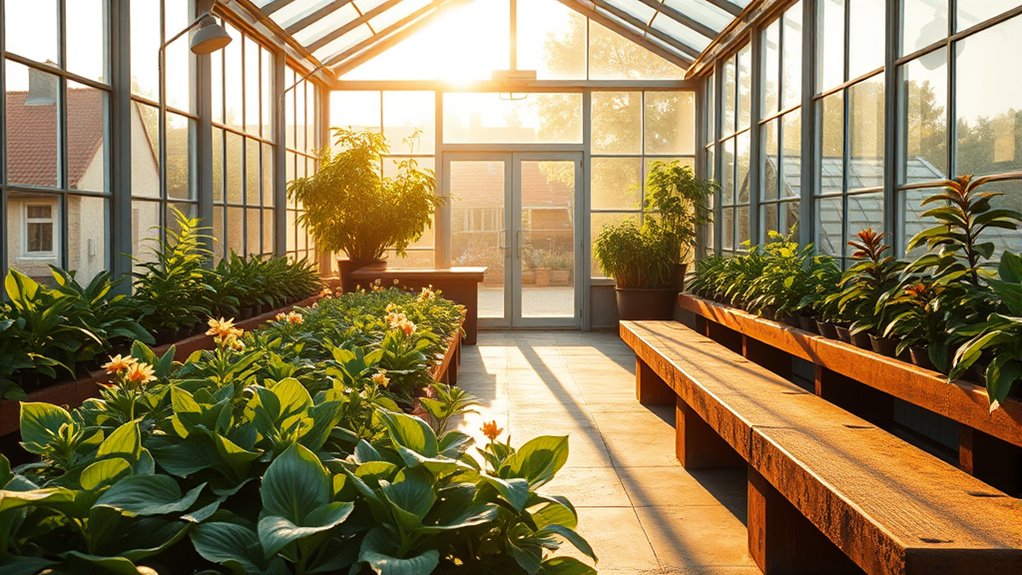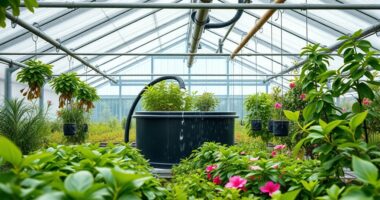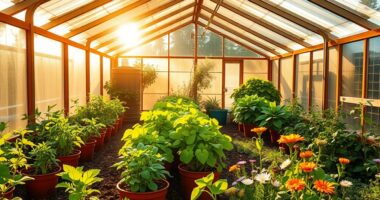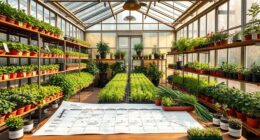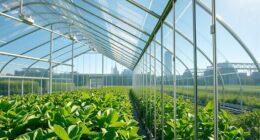To stabilize your greenhouse temperatures with thermal mass, incorporate materials like concrete, water, or stone into your design, focusing on their high heat capacities. Place these materials where they can absorb sunlight and be in contact with warm air, such as floors or walls. Insulate well to minimize heat loss overnight. Combining proper material choice and placement with effective insulation helps create a consistent environment. Continue exploring how optimizing your thermal mass setup can improve climate control even further.
Key Takeaways
- Incorporate high heat capacity materials like concrete or water into greenhouse floors or walls to absorb and gradually release heat.
- Position thermal mass where it can effectively receive sunlight during the day to maximize heat absorption.
- Use insulation techniques such as double-glazing and foam panels to minimize heat loss and prolong stored thermal energy.
- Strategically place thermal mass to create a balanced environment, reducing temperature fluctuations overnight.
- Combine thermal mass with proper insulation and placement to maintain stable, optimal temperatures for plant health.
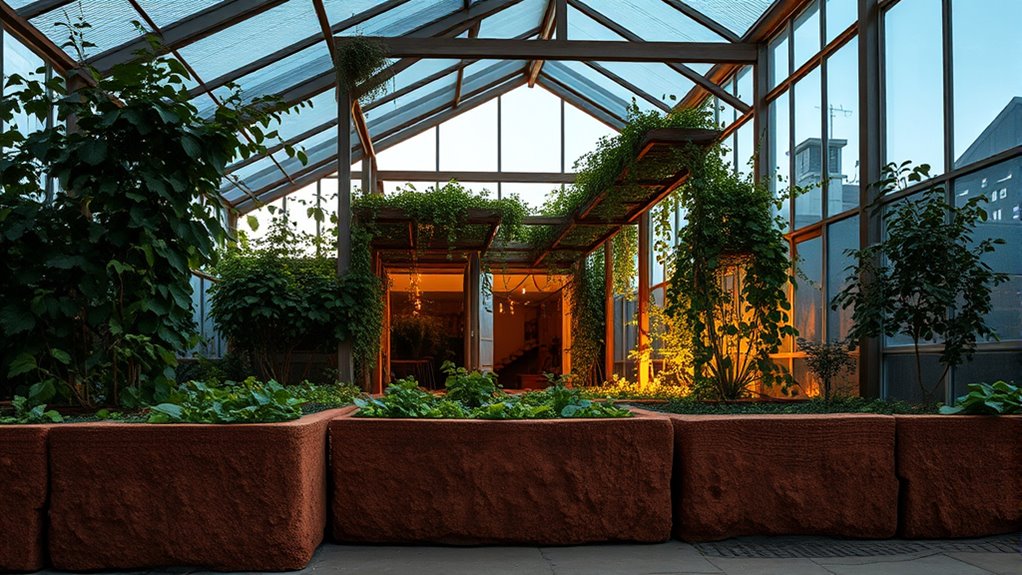
Thermal mass plays a essential role in maintaining stable temperatures inside greenhouses, helping to absorb, store, and gradually release heat. When it comes to optimizing this process, your choice of material selection becomes critical. You want materials with high specific heat capacity, such as concrete, water, or stone, which can effectively store thermal energy during the day and release it at night. Proper material selection guarantees that your greenhouse maintains a more consistent temperature, reducing the need for additional heating or cooling. It’s necessary to consider the placement of these materials as well; integrating them into the greenhouse floor or walls allows for maximum contact with the environment, enhancing their ability to regulate temperature fluctuations.
Optimizing thermal mass with high-capacity materials and strategic placement ensures stable greenhouse temperatures.
In addition to choosing the right materials, implementing effective insulation techniques amplifies the benefits of thermal mass. Well-insulated greenhouses minimize heat loss during cold nights, allowing the stored heat within your thermal mass to last longer. Techniques like double-glazing windows, insulated panels, or even adding reflective barriers can greatly improve thermal retention. You can also insulate the foundation and walls with foam boards or other insulating materials to prevent drafts and heat leaks. The goal is to create a balanced environment where the thermal mass can work efficiently without losing heat prematurely. This combination of material selection and insulation techniques results in a more stable microclimate, promoting healthy plant growth and reducing energy costs.
Another aspect to think about is the strategic placement of thermal mass in relation to sunlight exposure. Positioning heavy materials where they can receive ample sunlight during the day allows them to absorb maximum heat, which they then release slowly into the greenhouse overnight. This deliberate placement maximizes the thermal mass’s efficiency and helps stabilize temperature swings. Meanwhile, insulating key areas from cold drafts and thermal bridges prevents uneven heat distribution, ensuring that the stored heat is utilized effectively rather than wasted.
Ultimately, your success in using thermal mass depends on thoughtful material selection and robust insulation techniques. By choosing materials with high heat capacity and insulating your greenhouse effectively, you create a more controlled environment that reduces temperature fluctuations. Incorporating eco-friendly materials can further enhance the sustainability of your setup, supporting environmentally responsible gardening practices. This approach not only enhances plant health but also lowers energy consumption and operational costs. When you optimize these elements, you turn your greenhouse into a resilient, energy-efficient space that leverages natural heat storage to maintain consistent internal temperatures, regardless of external weather variations.
Frequently Asked Questions
How Does Thermal Mass Affect Humidity Levels in a Greenhouse?
Thermal mass helps regulate humidity control by moderating temperature fluctuations, which reduces excessive condensation and maintains stable moisture levels. When you use thermal mass, you create a more consistent environment, preventing sudden drops in temperature that can cause humidity spikes. This stability supports plant health by avoiding mold and diseases caused by high humidity, ensuring your greenhouse remains a healthy, balanced space for your plants to thrive.
Can Thermal Mass Be Used Effectively in Small-Scale Greenhouses?
Sure, thermal mass works wonders in small greenhouses, proving that size isn’t everything. You’ll find that thermal mass efficiency truly shines when paired with good greenhouse insulation, helping you regulate temperature swings. Small-scale setups benefit just as much, if not more, because you can easily incorporate materials like water barrels or concrete to absorb and release heat. So, yes, thermal mass can be a smart, effective choice for your compact greenhouse.
What Materials Are Best for Thermal Mass in Greenhouses?
You should choose materials with excellent thermal storage and durability for thermal mass in your greenhouse. Concrete, brick, and stone are ideal because they absorb and release heat effectively, helping to stabilize temperatures. Water tanks also work well due to their high thermal storage capacity. Pick durable options that can withstand humidity and temperature fluctuations, ensuring your thermal mass remains effective and long-lasting over time.
How Does Thermal Mass Influence Energy Costs During Winter?
Think of thermal mass as your greenhouse’s cozy blanket during winter. It absorbs heat during the day and slowly releases it at night, reducing your reliance on heating systems. This improves thermal insulation and enhances heat retention, which cuts energy costs considerably. By stabilizing temperatures, thermal mass acts like a buffer, making your greenhouse more energy-efficient and saving you money while keeping your plants warm and happy.
Are There Environmental Considerations When Choosing Thermal Mass Materials?
When choosing thermal mass materials, you should consider environmental impacts like sourcing and recyclability. Opt for sustainable materials such as recycled concrete or natural stone that have low embodied energy. Recyclability concerns matter because you want materials that can be reused or safely disposed of at end-of-life. By selecting eco-friendly options, you help reduce your greenhouse’s carbon footprint and promote sustainable building practices.
Conclusion
By incorporating thermal mass into your greenhouse, you naturally balance temperatures, saving energy and protecting your plants. As the sun rises and falls, the thermal mass absorbs and releases heat, creating a steady environment. It’s a simple coincidence—your efforts and nature working together—that keeps your greenhouse stable. Embrace this natural rhythm, and you’ll find that thermal mass not only moderates temperature but also brings harmony to your growing space.
